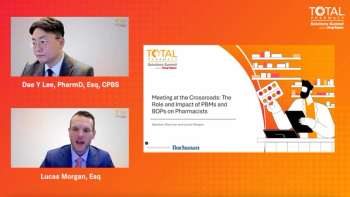
- Drug Topics July 2019
- Volume 163
- Issue 7
Mass. HPC: Transparency for PBM Spread Pricing
Results from a new Massachusetts Health Policy Commission report.
The Massachusetts Health Policy Commission (HPC) is calling for more oversight in spread pricing by pharmacy benefit managers (PBMs).
In a new report, HPC examined spread pricing and its impact on the state’s commercial health plans and Medicaid. The findings were presented recently at an HPC’s Market Oversight and Transparency committee meeting.
“The research released today illustrates the opaque and convoluted flow of healthcare dollars throughout the drug distribution chain,” HPC says in a prepared statement. “The HPC analysis concludes that greater transparency in the PBM drug pricing model is needed so payers can make more informed choices about allocation of state spending or premium dollars, including appropriate compensation for both pharmacies and PBMs.”
Trending:
HPC’s DataPoints report looked at PBM generic drug pricing in MassHealth Managed Care Organization (MCO) program as well as the commercial market.
“By industry estimates, the share of PBM revenue from spread pricing has grown from 22% in 2014 to 54% in 2016,” HPC states.
That finding led to an HPC recommendation to ratchet up oversight of PBM pricing practices “and take steps to limit the practice of spread pricing.” The report also called for greater transparency.
“Private and public health plans-along with employers and patients-need more information to make better informed spending decisions that will hopefully lead to an overall reduction in spending on pharmaceuticals,” adds David Seltz, HPC executive director.
A 2020 state budget proposal would limit PBM margins under contracts with MCOs and accountable care organizations (ACOs), HPC says.
To examine the potential impact of these different pricing practices, the HPC compared generic drug prices in the MassHealth MCO program and in the commercial market to the pharmacy acquisition cost for the drug, based on the National Average Drug Acquisition Cost (NADAC). “The difference between the payer price and NADAC is largely comprised of the dispensing fee to pharmacies and the potential profit retained by PBMs. The HPC also compared the MCO/PBM prices to FFS, using FFS prices as a benchmark for the pass-through pricing model that includes the set dispensing fee of $10.02 per prescription.”
Read More:
Key findings:
- In 2017, drug spending in Massachusetts increased by 4.1%.
- MassHealth drug spending nearly doubled in five years from $1.1 billion in 2012 go $1.9 billion in 2017.
- Spread pricing covered 22% of PBM salaries in 2014 and about 54% in 2016.
- “PBM payments to pharmacies are sometimes even below the pharmacy’s acquisition costs of the drugs, which can affect the financial viability of pharmacies and potentially impact access to care.”
- In the fourth quarter last year, MCOs paid an average $159.24 per prescription buprenorphine-naloxone 8-2 mg, which was 111% higher than the average Medicaid fee for service price of $75.53.
- PBMs assert that spread pricing models provide more predictability for health plans than pass-through models, in which drug prices for plans fluctuate directly with changes in drug acquisition cost. However, with greater transparency, payers can make informed choices about allocation of state spending or premium dollars, including appropriate compensation for both pharmacies and PBMs.
Articles in this issue
over 6 years ago
Opinion: Staying Afloatover 6 years ago
Pharmacists at the FDA: Drug Information Specialistsover 6 years ago
Compounding Industry on the Newest MOU Draftover 6 years ago
Opinion: Your Approach to Hiring is All Wrongover 6 years ago
New Drug Review: Erdafitinibover 6 years ago
10 Ways to Reduce Administrative Costsover 6 years ago
Implementing Enhanced Community Pharmacy Servicesover 6 years ago
New Institute Aims to Get the Medications Rightover 6 years ago
Vaccinations in the PipelineNewsletter
Pharmacy practice is always changing. Stay ahead of the curve with the Drug Topics newsletter and get the latest drug information, industry trends, and patient care tips.











































































































































































































